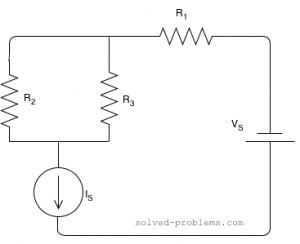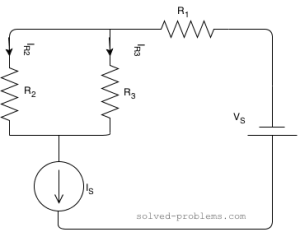Find current of resistors, use the current division rule.

Suppose that ![]() ,
, ![]() ,
, ![]() ,
, ![]() and
and ![]()
Solution:
![]() and
and ![]() are parallel. The current of
are parallel. The current of ![]() is passing through them and it is actually divided between them. The branch with lower resistance has higher current because electrons can pass through that easier than the other branch. Using the current division rule, we get
is passing through them and it is actually divided between them. The branch with lower resistance has higher current because electrons can pass through that easier than the other branch. Using the current division rule, we get
![]()
![]() .
.
Note that ![]() because
because ![]() .
.
What is the direction for ![]() and
and ![]() ? It is with the same direction as
? It is with the same direction as ![]() :
:

We have found ![]() and
and ![]() , now we need to find
, now we need to find ![]() .
.
If you look at the circuit carefully, ![]() ,
, ![]() and
and ![]() are all in series. The bottom node of
are all in series. The bottom node of ![]() is connected to the bottom node of
is connected to the bottom node of ![]() and there is no other component connected there. And the other node of
and there is no other component connected there. And the other node of ![]() is connected to
is connected to ![]() , again no other component here. This means that all current of
, again no other component here. This means that all current of ![]() should pass through
should pass through ![]() and the same current must go through
and the same current must go through ![]() . So, the current of
. So, the current of ![]() can be easily found:
can be easily found:
![]() .
.
The direction is the same current as the current source direction:

Now, tell me what is the voltage drop across the current source?
Leave a Reply